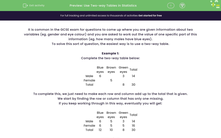It is common in the GCSE exam for questions to come up where you are given information about two variables (eg. gender and eye colour) and you are asked to work out the value of one specific part of this information (eg. how many males have blue eyes).
To solve this sort of question, the easiest way is to use a two-way table.
Example 1:
Complete the two-way table below:
| Blue eyes | Brown eyes | Green eyes | Total | |
| Male | 6 | 3 | 14 | |
| Female | 5 | |||
| Total | 8 | 30 |
To complete this, we just need to make each row and column add up to the total that is given.
We start by finding the row or column that has only one missing.
If you keep working through in this way, eventually you will get:
| Blue eyes | Brown eyes | Green eyes | Total | |
| Male | 6 | 5 | 3 | 14 |
| Female | 6 | 5 | 5 | 16 |
| Total | 12 | 10 | 8 | 30 |
Example 2:
100 people are asked whether they swim, cycle or run.
40 of the people were female.
26 of the 47 runners were female.
30 people swim.
10 men were cyclists.
a) Find the number of people who cycled.
Step 1 here is to draw a two-way table and enter the totals that we know:
| Swim | Run | Cycle | Total | |
| Male | 10 | |||
| Female | 26 | 40 | ||
| Total | 30 | 47 | 100 |
Once we have this, we can fill in the rest of the information:
| Swim | Run | Cycle | Total | |
| Male | 29 | 21 | 10 | 60 |
| Female | 1 | 26 | 13 | 40 |
| Total | 30 | 47 | 23 | 100 |
From this, it is quite easy to see that the total number of cyclists is 23.
b) Given that I choose a woman, what is the probability that she will be a runner?
Be careful with this one, we are limiting this to women only, so the probability will be out of 40.
26 of the women are runners, which makes our probability 26/40 which cancels to 13/20
Now let's have a go at some questions.








